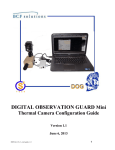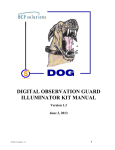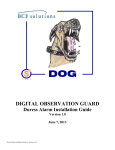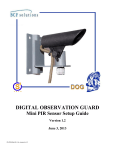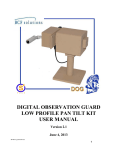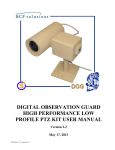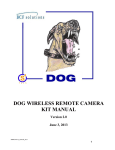Download DIGITAL OBSERVATION GUARD
Transcript
DIGITAL OBSERVATION GUARD Microwave Sensor Setup Guide Version 1.0 June 3, 2013 DS-MW-Kit-100/200/400-2-v1_manual-v1 Table of Contents Microwave Sensor Kit Description ......................................................................................................................................... 2 Setting up the Sensors ............................................................................................................................................................. 3 Connecting the Sensors to the Cameras .............................................................................................................................. 3 Mounting the Sensors on a Tripod ...................................................................................................................................... 4 Mounting the Sensors on a Wall ......................................................................................................................................... 5 Mounting the Sensors to a Pole........................................................................................................................................... 7 Sensor Adjustment and Fine Tuning....................................................................................................................................... 8 Performing the Walk Test ................................................................................................................................................... 8 Adjusting Sensor Range and Sensitivity Performance........................................................................................................ 8 Adjusting Sensor Range Performance ................................................................................................................................ 9 Adjusting Sensor Sensitivity Performance.......................................................................................................................... 9 Configuring the Alarm Inputs on the DOG Base Station ..................................................................................................... 10 Alarm Display During Operation.......................................................................................................................................... 11 Contact Info .......................................................................................................................................................................... 12 Replacement Parts ................................................................................................................................................................. 12 Table of Figures Figure 1: Microwave Sensor Coverage Pattern ...................................................................................................................... 2 Figure 2: Microwave Sensor Kit with Military Grade Case ................................................................................................... 2 Figure 3: Microwave Sensor Kit Identification Label ............................................................................................................ 3 Figure 4: Connecting Microwave Sensor to DOG Camera..................................................................................................... 3 Figure 5: Tripod Mounting Hardware ..................................................................................................................................... 4 Figure 6: Attaching Tripod Bracket to Tripod ........................................................................................................................ 4 Figure 7: Mounting Microwave Sensor to Tripod .................................................................................................................. 5 Figure 8: Wall Mounting Hardware ........................................................................................................................................ 5 Figure 9: Mounting Wall Bracket to Wall .............................................................................................................................. 6 Figure 10: Mounting Microwave Sensor to Wall Mount ........................................................................................................ 6 Figure 11: Pole Mounting Hardware ...................................................................................................................................... 7 Figure 12: Attaching Pole Mount to Pole ............................................................................................................................... 7 Figure 13: Mounting Microwave Sensor to Pole Mount ........................................................................................................ 8 Figure 14: Removing the Microwave Sensor’s Cover ............................................................................................................ 9 Figure 15: Setting the Sensor’s Range Cut-Off ...................................................................................................................... 9 Figure 16: Setting the Sensor’s Sensitivity ........................................................................................................................... 10 Figure 17: Find Alarm Configuration Menu ......................................................................................................................... 10 Figure 18: Configuring Channel Alarm Inputs for Normally Closed ................................................................................... 11 Figure 19: Sensor Alarm Indicators ...................................................................................................................................... 11 1 Microwave Sensor Kit Description The microwave sensor is an outdoor sensor designed to provide volumetric protection in a wide variety of indoor and outdoor applications. The sensor is capable of detecting a human sized intruder while walking, running, or crawling on hands and knees up to a distance of 122m (400ft) and a maximum width of 6m (20ft) as shown in the figure below. The range cut-off area is user selectable from 30m (100ft) to 122m (400ft). Figure 1: Microwave Sensor Coverage Pattern The Microwave Sensor Kit is an accessory kit for installation with the DOG Base Kit. Each DOG Microwave Sensor kit contains two Microwave sensors along with the necessary mounting hardware and associated accessories as shown in the figure below. Figure 2: Microwave Sensor Kit with Military Grade Case 2 Each case can be identified by a decal just above the handle as shown in the figure below. Figure 3: Microwave Sensor Kit Identification Label Setting up the Sensors With the DOG system, all sensors are paired with cameras to provide direct visual assessment of each alarm. The microwave sensor receives its power from the DOG remote camera module and transmits its alarms back to the DOG Base Station via the camera module also. The sensors plug into the sensor ports located on the side of the DOG remote module. Connecting the Sensors to the Cameras To connect the sensor to the remote camera module, simply remove the cap on the remote module sensor port as shown in the figure below. Line up the pins (and notch) on the sensor connector and push the sensor connector into the mating connector on the camera module. Twist the ring at the end of the sensor connector clockwise to lock and seal the connector in place. Figure 4: Connecting Microwave Sensor to DOG Camera 3 Mounting the Sensors on a Tripod To mount the microwave sensor on a tripod remove the sensor, ‘L’ bracket, and mounting hardware from the transit case as shown in the figure below. Figure 5: Tripod Mounting Hardware Begin by attaching the ‘L’ Bracket to the tripod using the threaded 3/8-16 hole on the bracket. Next screw an additional 3/8-16 nut from the mounting hardware bag onto the threaded stud followed by the large metal washer and finally the large rubber washer. Figure 6: Attaching Tripod Bracket to Tripod Screw the microwave sensor onto the threaded stud by turning the loose screw until it hits the bottom of the microwave sensor screw hole. With the solar shield is facing up, take a wrench and tighten the outer 3/8-16 nut so that the microwave sensor is no longer able to easily rotate on the threaded stud. 4 Figure 7: Mounting Microwave Sensor to Tripod Mounting the Sensors on a Wall To mount the microwave sensor on a wall remove the sensor, mounting plate, and mounting hardware from the transit case as shown in the figure below. Figure 8: Wall Mounting Hardware The hardware mounting bag contains several different types of screws to allow for mounting the sensor in various materials such as wood or concrete. The figure below shows a wall installation using concrete bolts. Begin by drilling a hole into the concrete just large enough for the reinforcing concrete bolt to fit into. Next take two of the appropriately sized screws and washers and screw the studded wall mount plate onto the wall. 5 Figure 9: Mounting Wall Bracket to Wall Once the studded wall mount plate is firmly attached to the wall screw a 3/8-16 nut followed by the large metal washer and finally the rubber washer onto the threaded stud. Attach the microwave sensor to the wall bracket by turning the screw into the threaded stud with the large nut loose. Once the sensor has been securely fastened to the wall mounting plate, use a wrench to tighten the 3/8-16 nut insuring the sensor will no longer be able to easily spin on the stud. Point the sensor in the desired direction and hold in place while tightening the large nut with a wrench as seen below. Figure 10: Mounting Microwave Sensor to Wall Mount 6 Mounting the Sensors to a Pole To mount the microwave sensor on a pole remove the sensor, mounting plate, ‘U’ bolts, and mounting hardware from the transit case as shown in the figure below. Figure 11: Pole Mounting Hardware Begin by attaching the wall mount plate to the pole using one of the provided ‘U’ bolts and nuts. The Microwave Sensor kit contains two different sized ‘U’ bolts to accommodate poles of varying sizes. Use a wrench to tighten both nuts on the ‘U’ so that the mounting plate is securely attached to the pole. Place the 3/816 nut on the threaded stud follow by the metal and finally the rubber washer. Figure 12: Attaching Pole Mount to Pole Next attach the microwave sensor to the wall mount plate by turning the screw into the threaded stud. Once the sensor has been securely fastened to the wall mounting plate, use a wrench to tighten the 3/8-16 nut insuring the sensor will no longer be able to easily spin on the stud. Point the sensor in the desired direction and hold in place while tightening the large nut with a wrench as seen below. 7 Figure 13: Mounting Microwave Sensor to Pole Mount Sensor Adjustment and Fine Tuning In order to assure the best possible protection and lowest false alarm performance of the sensor, it is highly recommended to perform a walk test once the sensor has been installed. The sensor provides both range and sensitivity controls to allow for fine tuning. Refer to the range and sensitivity adjustment sections below for instructions on how to adjust these settings. Performing the Walk Test To begin the walk test remain have a person walk outside the protection area of the sensor and wait until all alarms clear from the DOG Base Station. Next walk into the surveillance area while observing the DOG Base Station monitor. Verify that an alarm is received on the monitor. Adjusting Sensor Range and Sensitivity Performance In order to access the sensor’s range and sensitivity control switches the user must unscrew the six screws on the front of the sensor and carefully remove the front cover. NOTE** When reattaching the sensor cover the solar shield should be towards the top of the sensor. 8 Figure 14: Removing the Microwave Sensor’s Cover Adjusting Sensor Range Performance The range control switch adjusts the overall distance of the sensor’s detection area. The Microwave Sensor contains Range Cutoff (RCO) circuitry that allows users to set the maximum detection to a range of 100 ft - 400 ft. All objects detected beyond this range will be ignored by the sensor. The sensor is configured at the maximum distance of 400ft by default. However, it is recommended to set the range performance to the lowest setting to attain the desired range for a given scene. This helps to reduce nuisance alarms from objects outside the area of interest. Figure 15: Setting the Sensor’s Range Cut-Off Adjusting Sensor Sensitivity Performance The sensitivity control switch adjusts the amount of movement required for an alarm condition. The higher the setting value the more sensitive the sensor becomes requiring less detected motion before an alarm is triggered. The sensitivity control is the most critical adjustment for false alarm rejection. It is recommended to start at a relatively low sensitivity and slowly increase the sensitivity until false alarms begin to occur and then move the sensitivity setting back by one value. The sensor is configured with the sensitivity set to maximum by default. 9 Figure 16: Setting the Sensor’s Sensitivity Configuring the Alarm Inputs on the DOG Base Station Once the sensors are connected the DOG Base Station software must be configured to support normally closed alarm inputs. To get to the alarm input configuration screen click on the Event icon from the main menu and then select the Per Channel Config menu as shown in the figure below. Figure 17: Find Alarm Configuration Menu 10 Select the channel that you would like to configure in the Channel Select list and then select N/C in the Alarm In list. Press the ESC key on the DVR front panel or click on the red circle with the X in the upper right hand corner if you are using a USB mouse, in order to save the settings and escape to the next higher level menu. Repeat this operation for each channel that you would like to configure. When finished, push the ESC button repeatedly all the way back to the main menu. Figure 18: Configuring Channel Alarm Inputs for Normally Closed Alarm Display During Operation A red A will appear on the screen when there is a sensor alarm as seen in the figure below. Figure 19: Sensor Alarm Indicators 11 Contact Info For questions or support please see our website at: www.bcfsolutions.net or contact: [email protected], 703-956-9088. For user manual or other technical downloads go to the customer tab on the website and login with the following: user: customer password: 2004-S4Tech Replacement Parts The following replacement parts may be ordered for the DOG IR Illumination Kit. Credit card orders are accepted. Please contact S4 for order information. Part No. Description DRP-MS Replacement microwave sensor for DOG Microwave sensor kit. DRP-MS-BK Replacement ball joint microwave sensor bracket. 12














